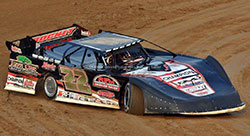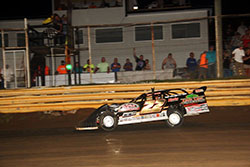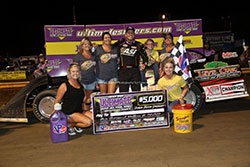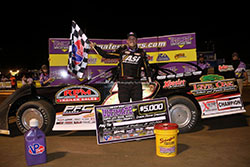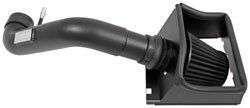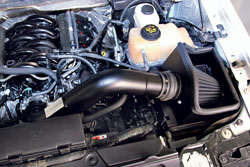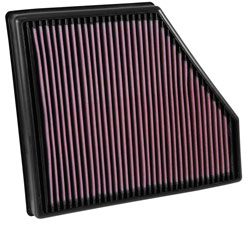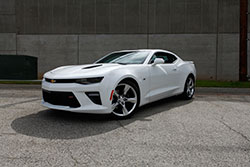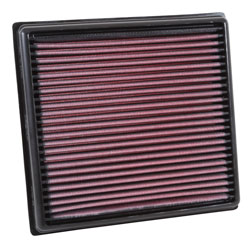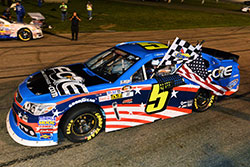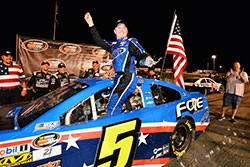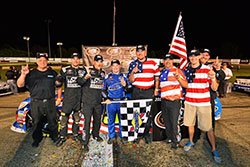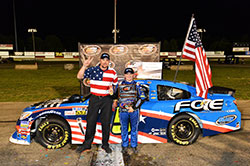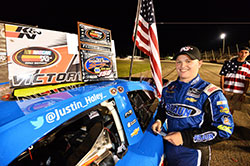Chris Ferguson Suffers Bad Luck Early Still Chalks Up Major Wins So Far in 2016
- 13 Jul 2016
"We've experienced some bad luck in three races so far this year," explained Ferguson, 26 and resident of Mt. Holly, North Carolina. "In one race we popped a tire with 10 laps to go; in another we were leading and crashed into the lap car; and in the third we had another flat tire." Still, he has chalked up four wins racing late models so far in 2016 including the 37th running of the USA 100 at the Virginia Motor Speedway in Jamaica, Virginia. In addition, even though he doesn't concentrate on regional series, he still ranks third in points in the Ultimate Super Late Models Series and fifth in points in the Carolina Clash Series. He has grown up in racing. His dad and his Uncles raced late models. "I grew up at race tracks watching my dad and uncles race," he said. "My dad bought me a go-kart when I was 13 and he took me to the local track to drive it. It wasn't long before I was racing. My dad quit racing at just about the time I got started so that he could focus on me and guide me through the sport." Ferguson also works for Butler Built Sports Equipment, manufacturer of racing seats for more than 30 years.
As an amateur racing go-karts, Ferguson won more than 100 feature races. Some of the main victories included the Daytona Dirt World Championship; the National World Karting Association (WKA) Championship twice; the WKA Grand Nationals, Jr. Kahuna, Goldspeed 100 and more. He graduated to Crate Late Models in 2006. His dad formed the racing team in 2010 that includes Bryan Conard, Corey Tanner, Cory Henson, David Chapman, and Steven Outz. He turned pro in 2011 and started racing late models at more national events. "That's when I started winning races outside my home area. When I was an amateur I raced mostly in the Carolinas. Since I turned pro I race anywhere on the east coast from Pennsylvania down to Florida, in the Midwest including Indiana, Ohio and Illinois and in Tennessee, Virginia, West Virginia, and Louisiana," he said. During his pro career he has won more than 50 special events races including two World of Outlaw championships, the top level of the sport. Other big races included The July 4th Special in Brunswick, Georgia; the Hall of Fame 100 at Cherokee Speedway in Gaffney, South Carolina; three-time winner of the Skylar Trull Memorial Race at the Carolina Speedway in Gastonia, North Carolina; World of Outlaw Blue Ridge Bash at Friendship Motor Speedway in Elkin, North Carolina; Ultimate at Golden Isle Speedway in Waynesville, Georgia; Ultimate Super Late Model Championship at the Virginia Motor Speedway; and more. He also holds the current track record at the Carolina Speedway; Toccoa Speedway in Toccoa, Georgia; Dublin Motor Speedway in Dublin, North Carolina; and the County Line Raceway in Elm City, North Carolina. According to Ferguson, there are 20 to 25 feature races left in this season in Illinois, Ohio, West Virginia, Virginia, North Carolina and South Carolina. The weekend of July 9-10, Ferguson and his team will make a three race swing through North Carolina, South Carolina, and Tennessee. "We will be racing in the Lucas Oil Late Model Series," he said. "There are three different races in three different states with the winner getting $10,000 for each race." He chooses the races in which he will compete based on the size of the purse.
"There are a lot of national races that have large purses," said Ferguson. "One pays $48,000 to the winner and is scheduled for September. There's another that pays $100,000 to the winner in Ohio in October and on and on. I'm drawn to races like that. A national race can pay $50,000 to $100,000 to the winner." In the coming months he will compete in:
"The World Finals is the season finale for the World Outlaw Late Models, World Outlaw Sprint Cars and big block modifieds ," explained Ferguson. "It's a big event that takes the weekend during which two races will be run. It concludes the season and it's a local race for me." K&N Engineering has been sponsoring Ferguson since 2010. "The relationship has been phenomenal. I've been very fortunate to work with Bob Harris initially and then during the last four years with Ryan Feldman. They have great products. Before they sponsored me I was running with K&N products for at least 10 years from my go-kart days through the Late Models. It was a product we already believed in. It's been great because of the following they have. Being supported by a brand that has been supporting racing for as long as it has is great for my team. I have been using K&N air filters and oil filters and their pre-filter since I have been racing go-karts. I've been using K&N products down to the air filter cleaners, the degreaser, and the air filter oil. Clements Racing Engines is also a sponsor and my engine builder. They've been in business for 35 years and is one of the top engine builders for dirt super late models. Before they knew I was using K&N products, they recommended them to me," he said. Other companies sponsoring Ferguson include: Langley Collision Center |
||||
|
||||

